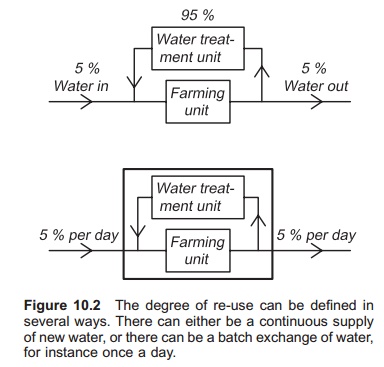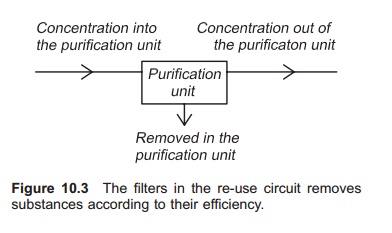Chapter: Aquaculture Engineering : Recirculationand Water Re-use Systems
Definitions for re-use or recycling systems
Definitions
To describe re-use or recycling systems a number of parameters are required.
Degree of re-use
Normally the degree of re-use (R) is used to give the percentage of the new incoming water (QN) in relation to the total amount of water (QT) flowing into the fish tank. This is described by the following relationship (Fig. 10.2):
R =(1−(QN/QT))×100
where:
R = degree of re-use
QN=new incoming water
QT=total water supply to the fish tank
= new incoming water + re-used water.

Example
If the supply of new water to a farm is 150 l/min and the total water flow is 1000 l/min calculate the degree of re-use.
R =(1−(QN/QT))×100
= (1 − (150/1000)) × 100
=85%
This, however, requires a continuous supply of new water, which also represents the normal way to operate a re-use farm.
Another way to operate a re-use system is to change the water in batches. This is the same as is done in aquaria, so information and knowledge from the operation of aquaria can be transferred to fish farming. However, in fish farming the emphasis is on optimal growth and this requires optimal environmental conditions; fish densities are also much higher. If the aim is for the fish to survive with some spare capacity, the requirement for water quality is reduced. For a re-use system that changes the water in batches, a given amount of water can be changed once a day or once a week, for instance. In this case the water quality will gradually decrease, until a new batch is exchanged and the quality returns to top level. In this case the degree of re-use can be expressed either as the percentage of water exchanged in relation to the total flow in the system throughout a day and night, or it can be given as the amount of water that is exchanged in relation to the total volume of water in the system (Fig. 10.2):
R =(1−(QB/QT))×100
where:
R = degree of re-use
QB=size of batch of new incoming water
QT=total amount of water flowing in the system between the exchanged batches of water.
R =(1−(QB/QT))×100
where:
R = degree of re-use
QB=size of batch of new incoming water
QT=total amount of water in the re-use system.
Example
The total amount of water in the system including the fish tank(s) and re-use circuit is 1000 l. The internal water flow in the system is 10 l/min. The amount of water in the exchange batch is 250 l and it is exchanged once a day. Calculate the degree of recycling based on both definitions.
R =(1−(QB/QT))×100
=(1 − (250/1000)) × 100
=75%
Total water flow in the system during a day: 10 l/min x 60 min x 24 h = 14 400 l.
R =(1−(QN/QT))×100
=(1 – (250/14 400) × 100
=98.3%
This example shows the importance of knowing which definition of re-use is used. Systems with continuous exchange of water and not batch systems are most commonly used.
Water exchange in relation to amount of fish
The degree of re-use does not, however, give enough information about the performance of the system and is not sufficient to describe a recirculation system properly. Neither does it take into account the amount of fish in the system. This can be illustrated in the following way: there are few problems in having only one fish in a large re-use system, compared to having a high density of fish in the same system. The degree of re-use for the systems can, however, be equal. To describe the re-use system it will also be necessary to know the amount of new water added per kg fish (litres new water per kg fish).
Example
A re-use system with a total tank volume of 100 m3 has a total circulating water flow of 2000 l/min. The re-use degree is 95%, meaning that the amount of added new water is 100 l/min. The fish density is in case 1, 10 kg/m3 and in case 2, 100 kg/m3. This represents a total amount of fish of respectively, 1000 kg and 10 000 kg, so the amount of new water in these cases is 0.1 l/(min kg fish) and 0.01 l/(min kg fish).
Even with this information it is difficult to compare re-use systems, because factors such as species, size and growth rate will have effects. For easily evaluating a separate re-use system, the growth rate of the fish is the best indicator. If the growth rate is optimal it can either be compared to growth tables or to growth in a flow-through system.
Degree of purification
Another important factor in re-use systems is the degree of cleaning CP of the water treatment system. This factor indicates how effectively the cleaning plant in the re-use circuit removes unwanted substances. It can be described as follows (Fig. 10.3):
CP=(Cin− Cout)/Cin×100
where:
CP = degree of purification
Cin=concentration of actual substance entering the cleaning unit
Cout=concentration of actual substance leaving the cleaning unit.

Example
The concentration of suspended solids entering the particle filter is 25 mg/l; after the filter the concentration is measured as 10 mg/l. Find the effectiveness of the filter.
CP=(Cin− Cout)/Cin×100
=(25 mg/l – 10 mg/l)/25 mg/l × 100
=60%
Related Topics